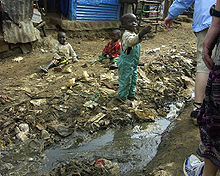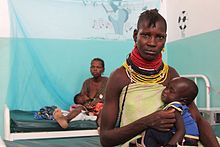Malnutrition in children
| Malnutrition in children | |
|---|---|
 | |
| Malnutrition due to soil transmitted helminth infections in school-age children in Guimaras Island, Philippines | |
| Symptoms | Stunted growth, underweight, wasting[1] |
| Deaths | 1 million a year[2] |
Malnutrition in children – here understood as undernutrition – is common globally and results in both short and long term irreversible negative health outcomes including stunted growth which may also be linked to cognitive development deficits, underweight and wasting. The World Health Organization (WHO) estimates that malnutrition accounts for 54 percent of child mortality worldwide,[3] about 1 million children.[2] Another estimate also by WHO states that childhood underweight is the cause for about 35% of all deaths of children under the age of five years worldwide.[4]
The main causes are unsafe water, inadequate sanitation or insufficient hygiene, factors related to society and poverty, diseases, maternal factors, gender issues and – overall – poverty.
Contents
[hide]Signs and symptoms[edit]
Measures[edit]
There are three commonly used measures for detecting malnutrition in children:
- stunting (extremely low height for age),
- underweight (extremely low weight for age), and
- wasting (extremely low weight for height).[1]
These measures of malnutrition are interrelated, but studies for the World Bank found that only 9 percent of children exhibit stunting, underweight, and wasting.[1]
Children with severe acute malnutrition are very thin, but they often also have swollen hands and feet, making the internal problems more evident to health workers.[5]
Children with severe malnutrition are very susceptible to infection.[3]
Effects later in life[edit]
Undernutrition in children causes direct structural damage to the brain and impairs infant motor development and exploratory behavior.[6] Children who are undernourished before age two and gain weight quickly later in childhood and in adolescence are at high risk of chronic diseases related to nutrition.[6]
Studies have found a strong association between undernutrition and child mortality.[7] Once malnutrition is treated, adequate growth is an indication of health and recovery.[3] Even after recovering from severe malnutrition, children often remain stunted for the rest of their lives.[3]
Even mild degrees of malnutrition double the risk of mortality for respiratory and diarrheal disease mortality and malaria.[3] This risk is greatly increased in more severe cases of malnutrition.[3]
Undernourished girls tend to grow into short adults and are more likely to have small children.[6]
Prenatal malnutrition and early life growth patterns can alter metabolism and physiological patterns and have lifelong effects on the risk of cardiovascular disease.[6] Children who are undernourished are more likely to be short in adulthood, have lower educational achievement and economic status, and give birth to smaller infants.[6] Children often face malnutrition during the age of rapid development, which can have long-lasting impacts on health.[3]
Causes[edit]
Inadequate food intake, infections, psychosocial deprivation, the environment (lack of sanitation and hygiene), social inequality and perhaps genetics contribute to childhood malnutrition.[3]
Sanitation[edit]
The World Health Organisation estimated in 2008 that globally, half of all cases of undernutrition in children under five were caused by unsafe water, inadequate sanitation or insufficient hygiene.[4] This link is often due to repeated diarrhoea and intestinal worm infections as a result of inadequate sanitation.[8] However, the relative contribution of diarrhea to undernutrition and in turn stunting remains controversial.[9]
Social inequality[edit]
In almost all countries, the poorest quintile of children has the highest rate of malnutrition.[1] However, inequalities in malnutrition between children of poor and rich families vary from country to country, with studies finding large gaps in Peru and very small gaps in Egypt.[1] In 2000, rates of child malnutrition were much higher in low income countries (36 percent) compared to middle income countries (12 percent) and the United States (1 percent).[1]
Studies in Bangladesh in 2009 found that the mother’s literacy, low household income, higher number of siblings, less access to mass media, less supplementation of diets, unhygienic water and sanitation are associated with chronic and severe malnutrition in children.[10]
Diseases[edit]
Diarrhea and other infections can cause malnutrition through decreased nutrient absorption, decreased intake of food, increased metabolic requirements, and direct nutrient loss.[11]Parasite infections, in particular intestinal worm infections (helminthiasis), can also lead to malnutrition.[11] A leading cause of diarrhea and intestinal worm infections in children in developing countries is lack of sanitation and hygiene. Other diseases that cause chronic intestinal inflammation may lead to malnutrition, such as some cases of untreated celiac disease and inflammatory bowel disease.[12][13][14]
Children with chronic diseases like HIV have a higher risk of malnutrition, since their bodies cannot absorb nutrients as well.[5] Diseases such as measles are a major cause of malnutrition in children; thus immunizations present a way to relieve the burden.[5]
Maternal factors[edit]
The nutrition of children 5 years and younger depends strongly on the nutrition level of their mothers during pregnancy and breastfeeding.[15]
Infants born to young mothers who are not fully developed are found to have low birth weights.[16] The level of maternal nutrition during pregnancy can affect newborn body size and composition.[6] Iodine-deficiency in mothers usually causes brain damage in their offspring, and some cases cause extreme physical and mental retardation. This affects the children’s ability to achieve their full potential. In 2011 UNICEF reported that thirty percent of households in the developing world were not consuming iodized salt, which accounted for 41 million infants and newborns in whom iodine deficiency could still be prevented.[17] Maternal body size is strongly associated with the size of newborn children.[6]
Short stature of the mother and poor maternal nutrition stores increase the risk of intrauterine growth retardation (IUGR).[6] However, environmental factors can weaken the effect of IUGR on cognitive performance.[6]
Gender[edit]
A study in Bangladesh in 2008 reported that rates of malnutrition were higher in female children than male children.[10] Other studies show that, at the national level, differences between undernutrition prevalence rates between young boys and girls are generally small.[18] Girls often have a lower nutritional status in South and Southeastern Asia compared to boys.[18] In other developing regions, the nutritional status of girls is slightly higher.[18]
Diagnosis[edit]
Measurements of a child’s growth provide the key information for the presence of malnutrition, but weight and height measurements alone can lead to failure to recognize kwashiorkor and an underestimation of the severity of malnutrition in children.[3]
Prevention[edit]
Measures have been taken to reduce child malnutrition. Studies for the World Bank found that, from 1970 to 2000, the number of malnourished children decreased by 20 percent in developing countries.[1] Iodine supplement trials in pregnant women have been shown to reduce offspring deaths during infancy and early childhood by 29 percent.[5] However, universal salt iodization has largely replaced this intervention.[5]
The Progresa program in Mexico combined conditional cash transfers with nutritional education and micronutrient-fortified food supplements; this resulted in a 10 percent reduction the prevalence of stunting in children 12–36 months old.[7] Milk fortified with zinc and iron reduced the incidence of diarrhea by 18 percent in a study in India.
Treatment[edit]
Treatment with antibiotics such as amoxicillin or cefdinir improve the response and survival rate of severely malnourished children to an outpatient treatment plan which provided therapeutic food.[2] This confirms the recommendation, "In addition to the provision of RUTF [ready-to-use therapeutic food], children need to receive a short course of basic oral medication to treat infections." contained in "Community-based management of severe acute malnutrition, A Joint Statement by the World Health Organization, the World Food Programme, the United Nations System Standing Committee on Nutrition and the United Nations Children’s Fund."[19]
Breastfeeding[edit]
Breastfeeding can reduce rates of malnutrition and dehydration caused by diarrhea, but mothers are sometimes wrongly advised to not breastfeed their children.[5] Breastfeeding has been shown to reduce mortality in infants and young children.[7] Since only 38 percent of children worldwide under 6 months are exclusively breastfed, education programs could have large impacts on children malnutrition rates.[20]However, breastfeeding cannot fully prevent PEM if not enough nutrients are consumed.[3]
Epidemiology[edit]
The World Health Organization estimates that malnutrition accounts for 54 percent of child mortality worldwide,[3] about 1 million children.[2]Another estimate also by WHO states that childhood underweight is the cause for about 35% of all deaths of children under the age of five years worldwide.[4]
According to a 2008 review an estimated 178 million children under age 5 are stunted, most of whom live in sub-Saharan Africa.[7] A 2008 review of malnutrition found that about 55 million children are wasted, including 19 million who have severe wasting or severe acute malnutrition.[7]
As underweight children are more vulnerable to almost all infectious diseases, the indirect disease burden of malnutrition is estimated to be an order of magnitude higher than the disease burden of the direct effects of malnutrition.[4] The combination of direct and indirect deaths from malnutrition caused by unsafe water, sanitation and hygiene (WASH) practices is estimated to lead to 860,000 deaths per year in children under five years of age.[4]




No hay comentarios:
Publicar un comentario